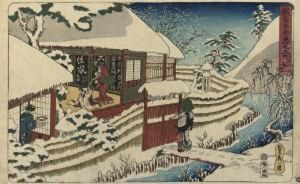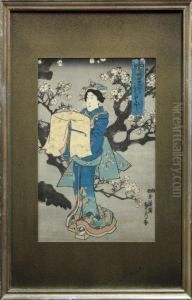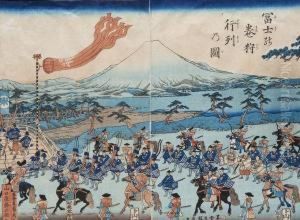Sadahide Utagawa Paintings
Sadahide Utagawa, born in 1807 and deceased in 1873, was a prominent figure in the Japanese ukiyo-e genre of woodblock prints and paintings. He was part of the prolific Utagawa school, which significantly influenced the development and popularity of ukiyo-e in Edo-period Japan. Sadahide's real name was Hashimoto Kenjirō, and he was also known by the art names Gountei Sadahide and Gyokuransai Sadahide. His works are celebrated for their intricate detail and dynamic compositions, capturing the vibrancy of Edo (modern-day Tokyo) and other locales during a period of significant social and political change.
Sadahide became a student of Utagawa Kunisada, one of the most renowned ukiyo-e artists of the time, in the 1820s. Under Kunisada's tutelage, Sadahide honed his skills in the traditional subjects of ukiyo-e, including kabuki actors, beautiful women, and historical scenes. However, he is perhaps best known for his landscapes and Yokohama-e, prints that depicted the foreigners and new technologies arriving in Yokohama after Japan ended its period of national isolation in the 1850s. These works not only offer valuable insights into how the Japanese viewed the outside world during a pivotal period in their history but also showcase Sadahide's adaptability to new themes and his keen observational skills.
Throughout his career, Sadahide also contributed to various types of woodblock printed books, including illustrated guides, encyclopedias, and maps. His detailed and accurate map prints are particularly noteworthy, reflecting both his artistic talent and a keen interest in geography. These contributions are indicative of the ukiyo-e genre's evolution from primarily focusing on pleasure district subjects to embracing a wider array of themes, including education and information dissemination.
Sadahide's legacy is evident in the lasting popularity of his prints and the way in which his work encapsulates the transitional era of late Edo and early Meiji Japan. His ability to capture the essence of his time, from the bustling street life of Edo to the curious gaze upon foreign lands and peoples, makes his oeuvre a valuable asset for both art enthusiasts and historians alike. Sadahide Utagawa remains a significant figure in the study of Japanese ukiyo-e, offering a window into the cultural and societal shifts of 19th-century Japan.

![Yokohama Ijin Shokan Uriba No Zu [view Of The Trading Floor In A Foreign Building In Yokohama], A Triptych Depicting In Detail The Interior Of A Trader's House With Two Western Clerks, A Chinese Man Holding Up A Length Of Cloth, Etc.](https://www.niceartgallery.com/imgs/1058407/s/sadahide-utagawa-yokohama-ijin-shokan-uriba-no-zu-view-of-the-trading-floor-in-a-foreign-building-in-yokohama-a-triptych-depicting-in-detail-the-interior-of-a-traders-house-with-two-western-clerks-a-chinese-man-holding-up-a-length-of-cloth-etc-c59230e3.jpg)


